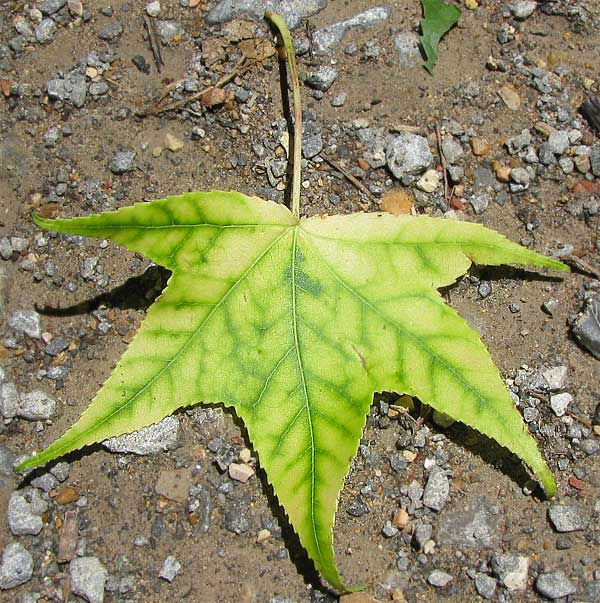When attempting to diagnose a nutrient deficiency, trees should be inspected for visual symptoms. The following explores some of the symptoms associated with nitrogen, phosphorous, potassium, sulfur, and zinc deficiencies, and how each type of deficiency affects deciduous trees, and conifers.
Nitrogen Deficiency
Nitrogen is an important constituent of the chlorophyll molecule. It also occurs in various proteins, alkaloids, and vitamins. Nitrogen is a vital resource for trees, assisting in plant growth, and root development. It is one of the most widespread types of nutrient deficiency.
Deciduous Trees:
In deciduous trees, leaves may appear discolored, fading from green to yellow. The color becomes especially pronounced in older trees. Leaves may experience stunted growth, with new leaves often emerging small and thin. Affected trees may shed their leaves prematurely. Shoots and branches may develop a reddish-brown tinge, and will often be shorter and smaller in diameter. As the deficiency increases, the growth rate of the tree may decline sharply.
Conifers:
In affected conifers, needles will often grow short and close together. Mature conifers may exhibit poor needle retention, shedding foliage as the deficiency increases. The lower crown may turn yellow, while the upper crown remains green.
Phosphorous Deficiency
Trees require an abundant supply of phosphorous to survive. The high energy bonds of phosphate groups enable trees to transfer energy more efficiently, stimulating their growth. Phosphorous deficiency occurs frequently in certain deciduous trees and conifers, but is less common in fruit trees.
Deciduous Trees:
In deciduous trees, a phosphorous deficiency may cause the veins, petioles, and lower surfaces of leaves to develop a bronze or violet color. Depending on the species of tree, older leaves may vary in coloration from red to yellow. Foliage may be sparse in affected trees, often resulting in compacted, or malformed branches. Affected trees may experience a premature shedding of leaves throughout the crown. In trees with a severe deficiency, shoots will appear normal in length, but smaller in diameter.
Conifers:
Needles turn purple in seedlings, with discoloration beginning at the tips of lower needles, and progressing inwards and upwards through the crown. Older trees often develop a dull blue or gray color. Affected conifers may form fewer secondary needles, with some forming none at all. Needles will likely die back, beginning in the lower regions of the crown, and spreading upwards. Buds may set early, and seedlings may remain dormant for longer than usual.
Potassium Deficiency
Trees require large amounts of potassium. Potassium deficiency is especially common in fruit trees, and forested trees, with symptoms varying among species.
Deciduous Trees:
In deciduous trees, older leaves are the first to exhibit signs of a potassium deficiency. Affected leaves will develop marginal and interveinal chlorosis, followed by scorching, and necrotic spotting throughout the leaf. As the deficiency increases, leaves may crinkle, and roll upward. Shoot tips often die back late in the season, with shoots from lateral buds developing an abnormal growth pattern.
Conifers:
In conifers, older foliage gradually turns from green to dark blue before progressing to a yellow or brown color. Necrosis may occur at needle tips, often resulting in foliar dieback. Needle retention is often poor, resulting in bare patches throughout the tree’s crown. Affected conifers tend to have short, thick abundant buds. Conifers with a potassium deficiency have an increased susceptibility to wind and frost injury.
Sulfur Deficiency
Sulfur is an essential constituent of many proteins and vitamins. It is also a major component of soil organic matter, and is integral to ensuring proper root growth and development. Sulfur deficiency exhibits many symptoms associated with nitrogen deficiency, but it not as widespread.
Broadleaf Trees:
Sulfur deficiency appears first on older leaves. Leaves that are affected by a sulfur deficiency will be stunted in their growth. As the deficiency progresses, leaves turn a pale yellow color. Emerging shoots are often short in diameter.
Conifers:
Discoloration of needle tips may occur, with needles turning a yellow, red, or mottled color. This is particularly common on older needles. Necrosis of needle tips, and dieback may occur, followed by significant needle loss.
Zinc Deficiency
Zinc is a micro-nutrient in trees that is required in small quantities. Zinc deficiency is one of the least common nutritional deficiencies. It is seldom found in fruit trees or deciduous trees.
Deciduous Trees:
In deciduous tree, leaves will transition from green to yellow. Younger leaves will become severely chlorotic. Over time, they will develop a mottled appearance, with frequent necrotic spotting. Affected trees may experience a premature shedding of older leaves. Shoots that grow tufts of leaves at their tips may die back.
Conifers:
Needles gradually turn from green to yellow. Branches and needles will likely be stunted, with necrosis occurring at the tips. Eventually, needles may drop, resulting in significant foliar loss.


